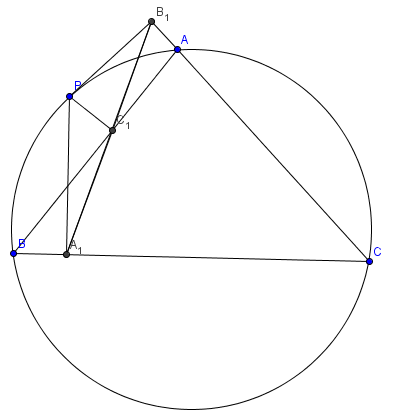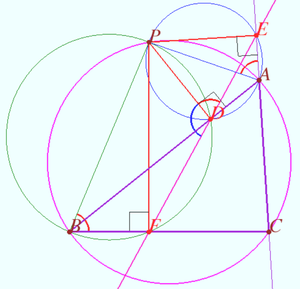Difference between revisions of "Simson line"
(→Simson line (main)) |
(→Simson line (main)) |
||
| Line 13: | Line 13: | ||
Let the point <math>P</math> be on the circumcircle of <math>\triangle ABC.</math> | Let the point <math>P</math> be on the circumcircle of <math>\triangle ABC.</math> | ||
| − | <math>\angle BFP = \angle BDP = 90^\circ \implies BPDF</math> is cyclic <math>\implies \angle PDF = 180^\circ – \angle CBP.</math> | + | |
| − | <math>\angle ADP = \angle AEP = 90^\circ \implies AEPD</math> is cyclic <math>\implies \angle PDE = \angle PAE.</math> | + | <math>\angle BFP = \angle BDP = 90^\circ \implies</math> |
| + | |||
| + | <math>BPDF</math> is cyclic <math>\implies \angle PDF = 180^\circ – \angle CBP.</math> | ||
| + | |||
| + | <math>\angle ADP = \angle AEP = 90^\circ \implies</math> | ||
| + | |||
| + | <math>AEPD</math> is cyclic <math>\implies \angle PDE = \angle PAE.</math> | ||
<math>ACBP</math> is cyclic <math>\implies \angle PBC = \angle PAE \implies \angle PDF + \angle PDE = 180^\circ</math> | <math>ACBP</math> is cyclic <math>\implies \angle PBC = \angle PAE \implies \angle PDF + \angle PDE = 180^\circ</math> | ||
| + | |||
<math>\implies D, E,</math> and <math>F</math> are collinear as desired. | <math>\implies D, E,</math> and <math>F</math> are collinear as desired. | ||
| Line 24: | Line 31: | ||
[[File:Simson line inverse.png|300px|right]] | [[File:Simson line inverse.png|300px|right]] | ||
<math>AEPD</math> is cyclic <math>\implies \angle APE = \angle ADE, \angle APE = \angle BAC.</math> | <math>AEPD</math> is cyclic <math>\implies \angle APE = \angle ADE, \angle APE = \angle BAC.</math> | ||
| + | |||
<math>BFDP</math> is cyclic <math>\implies \angle BPF = \angle BDF, \angle DPF = \angle ABC.</math> | <math>BFDP</math> is cyclic <math>\implies \angle BPF = \angle BDF, \angle DPF = \angle ABC.</math> | ||
<math>\angle ADE = \angle BDF \implies \angle BPA = \angle EPF</math> | <math>\angle ADE = \angle BDF \implies \angle BPA = \angle EPF</math> | ||
| − | <math>= \angle BAC + \angle ABC = 180^\circ – \angle ACB \implies ACBP</math> is cyclis as desired. | + | |
| + | <math>= \angle BAC + \angle ABC = 180^\circ – \angle ACB \implies</math> | ||
| + | |||
| + | <math>ACBP</math> is cyclis as desired. | ||
'''vladimir.shelomovskii@gmail.com, vvsss''' | '''vladimir.shelomovskii@gmail.com, vvsss''' | ||
Revision as of 14:47, 30 November 2022
In geometry, given a triangle ABC and a point P on its circumcircle, the three closest points to P on lines AB, AC, and BC are collinear.

Proof
In the shown diagram, we draw additional lines ![]() and
and ![]() . Then, we have cyclic quadrilaterals
. Then, we have cyclic quadrilaterals ![]() ,
, ![]() , and
, and ![]() . (more will be added)
. (more will be added)
Simson line (main)
Let a triangle ![]() and a point
and a point ![]() be given. Let
be given. Let ![]() and
and ![]() be the foots of the perpendiculars dropped from P to lines AB, AC, and BC, respectively.
be the foots of the perpendiculars dropped from P to lines AB, AC, and BC, respectively.
Then points ![]() and
and ![]() are collinear iff the point
are collinear iff the point ![]() lies on circumcircle of
lies on circumcircle of ![]()
Proof
Let the point ![]() be on the circumcircle of
be on the circumcircle of ![]()
![]()
![]() is cyclic
is cyclic ![]()
![]()
![]() is cyclic
is cyclic ![]()
![]() is cyclic
is cyclic ![]()
![]() and
and ![]() are collinear as desired.
are collinear as desired.
Proof
Let the points ![]() and
and ![]() be collinear.
be collinear.
![]() is cyclic
is cyclic ![]()
![]() is cyclic
is cyclic ![]()
![]()
![]()
![]() is cyclis as desired.
is cyclis as desired.
vladimir.shelomovskii@gmail.com, vvsss











